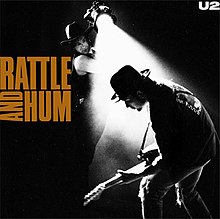Van Diemen's Land (song)
| Rattle and Hum | ||||
|---|---|---|---|---|

Artwork for compact disc release
|
||||
| Studio album with live tracks by U2 | ||||
| Released | 10 October 1988 | |||
| Recorded | 1987–88 | |||
| Studio |
|
|||
| Genre | Rock, roots rock | |||
| Length | 72:27 | |||
| Label | Island | |||
| Producer | Jimmy Iovine | |||
| U2 chronology | ||||
|
||||
| Singles from Rattle and Hum | ||||
|
||||
| Professional ratings | |
|---|---|
| Review scores | |
| Source | Rating |
| AllMusic | |
| Encyclopedia of Popular Music | |
| The Great Rock Discography | 8/10 |
| Los Angeles Times | |
| MusicHound | 4/5 |
| NME | 8/10 |
| Rolling Stone | |
| The Rolling Stone Album Guide | |
| Spin Alternative Record Guide | 5/10 |
| The Village Voice | B+ |
| U2: Rattle and Hum | |
|---|---|

Theatrical release poster
|
|
| Directed by | Phil Joanou |
| Produced by | Michael Hamlyn |
| Starring |
Bono The Edge Adam Clayton Larry Mullen, Jr. |
| Music by | Bono Adam Clayton Larry Mullen, Jr. The Edge |
| Cinematography | Robert Brinkmann (Black-and-white footage) Jordan Cronenweth (Color footage) |
| Edited by | Phil Joanou |
|
Production
company |
Midnight Films
|
| Distributed by | Paramount Pictures |
|
Release date
|
|
|
Running time
|
98 minutes |
| Country | United States |
| Language | English |
| Budget | $5 million |
| Box office | $8,600,823 |
Rattle and Hum is the sixth studio album by Irish rock band U2, and a companion rockumentary film directed by Phil Joanou, both released in 1988. The film and the album feature live recordings, covers, and new songs. To a greater extent than on their previous album, The Joshua Tree, the band explores American roots music and incorporates elements of blues rock, folk rock, and gospel music in their sound. The motion picture was filmed primarily in the United States in late 1987 during The Joshua Tree Tour and it features their experiences with American music.
Although Rattle and Hum was intended to represent the band paying tribute to rock legends, some critics accused U2 of trying to place themselves amongst the ranks of these artists. While critical reception was mixed, the album was a commercial success, reaching the number one spot in several countries and selling 14 million copies.
"I was very keen on the idea of going wide at a time like that, just seeing how big this thing could get. I had always admired Colonel Parker and Brian Epstein for realising that music could capture the imagination of the whole world."
While in Hartford during the 1987 The Joshua Tree Tour, U2 met film director Phil Joanou who made an unsolicited pitch to the band to make a feature-length documentary about the tour. Joanou suggested they hire Martin Scorsese, Jonathan Demme, or George Miller to direct the film. Joanou met the band again in Dublin to discuss the plans and again in France in September before the band chose him as director. The movie was originally titled U2 in the Americas and the band planned to film in Chicago and Buenos Aires later in the year. It was later decided that the Chicago venue wasn't suitable, and instead U2 used the McNichols Sports Arena in Denver to film. Following the success of Live at Red Rocks: Under a Blood Red Sky, which had been filmed in Denver four years earlier, the band hoped that "lightning might strike twice". With production problems and estimated costs of $1.2 million the band cancelled the plans for December concerts in South America. At the suggestions of concert promoter, Barry Fey, the band instead booked the Sun Devil Stadium in Arizona.
...
Wikipedia
